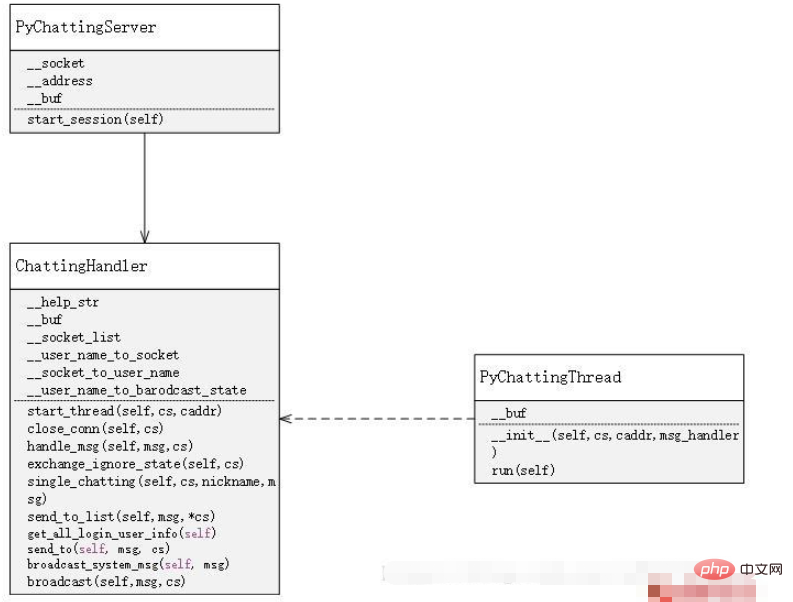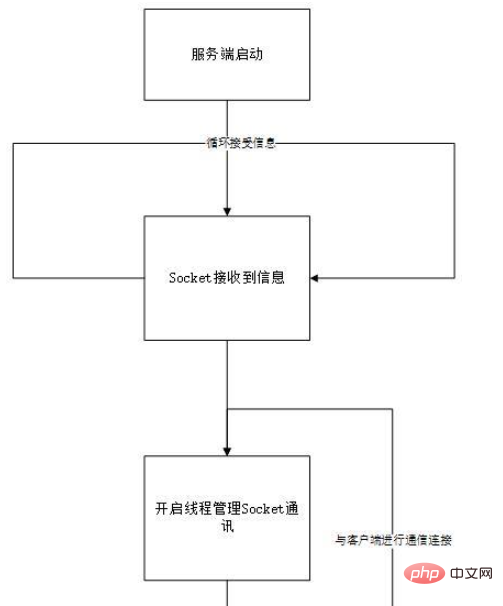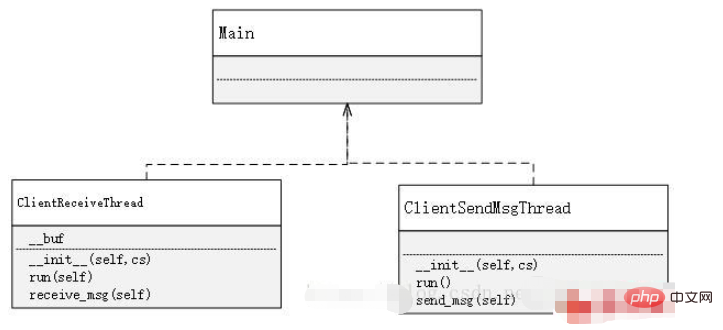Tutorial on writing a simple chat program in Python
Implementation ideas
x01 Establishment of the server
First, on the server side, use socket to accept messages. Every time a socket request is accepted, a socket is opened. A new thread is used to manage the distribution and acceptance of messages. At the same time, there is a handler to manage all threads, thereby realizing the processing of various functions of the chat room
x02 Establishment of the client
The establishment of the client is much simpler than the server. The function of the client is only to send and receive messages, and to enter specific characters according to specific rules to achieve the use of different functions. Therefore, in On the client side, you only need to use two threads, one is dedicated to receiving messages, and the other is dedicated to sending messages. As for why not use one, that is because, if you only use one, then After receiving a message, the one that receives the message is in a blocked state before sending it. Similarly, the same is true for sending a message. If these two functions are implemented in one place, it will make it impossible to continuously send or receive messages.
Implementation method
Server-side implementation

import json
import threading
from socket import *
from time import ctime
class PyChattingServer:
__socket = socket(AF_INET, SOCK_STREAM, 0)
__address = ('', 12231)
__buf = 1024
def __init__(self):
self.__socket.bind(self.__address)
self.__socket.listen(20)
self.__msg_handler = ChattingHandler()
def start_session(self):
print('等待客户连接...\r\n')
try:
while True:
cs, caddr = self.__socket.accept()
# 利用handler来管理线程,实现线程之间的socket的相互通信
self.__msg_handler.start_thread(cs, caddr)
except socket.error:
pass
class ChattingThread(threading.Thread):
__buf = 1024
def __init__(self, cs, caddr, msg_handler):
super(ChattingThread, self).__init__()
self.__cs = cs
self.__caddr = caddr
self.__msg_handler = msg_handler
# 使用多线程管理会话
def run(self):
try:
print('...连接来自于:', self.__caddr)
data = '欢迎你到来PY_CHATTING!请输入你的很cooooool的昵称(不能带有空格哟`)\r\n'
self.__cs.sendall(bytes(data, 'utf-8'))
while True:
data = self.__cs.recv(self.__buf).decode('utf-8')
if not data:
break
self.__msg_handler.handle_msg(data, self.__cs)
print(data)
except socket.error as e:
print(e.args)
pass
finally:
self.__msg_handler.close_conn(self.__cs)
self.__cs.close()
class ChattingHandler:
__help_str = "[ SYSTEM ]\r\n" \
"输入/ls,即可获得所有登陆用户信息\r\n" \
"输入/h,即可获得帮助\r\n" \
"输入@用户名 (注意用户名后面的空格)+消息,即可发动单聊\r\n" \
"输入/i,即可屏蔽群聊信息\r\n" \
"再次输入/i,即可取消屏蔽\r\n" \
"所有首字符为/的信息都不会发送出去"
__buf = 1024
__socket_list = []
__user_name_to_socket = {}
__socket_to_user_name = {}
__user_name_to_broadcast_state = {}
def start_thread(self, cs, caddr):
self.__socket_list.append(cs)
chat_thread = ChattingThread(cs, caddr, self)
chat_thread.start()
def close_conn(self, cs):
if cs not in self.__socket_list:
return
# 去除socket的记录
nickname = "SOMEONE"
if cs in self.__socket_list:
self.__socket_list.remove(cs)
# 去除socket与username之间的映射关系
if cs in self.__socket_to_user_name:
nickname = self.__socket_to_user_name[cs]
self.__user_name_to_socket.pop(self.__socket_to_user_name[cs])
self.__socket_to_user_name.pop(cs)
self.__user_name_to_broadcast_state.pop(nickname)
nickname += " "
# 广播某玩家退出聊天室
self.broadcast_system_msg(nickname + "离开了PY_CHATTING")
# 管理用户输入的信息
def handle_msg(self, msg, cs):
js = json.loads(msg)
if js['type'] == "login":
if js['msg'] not in self.__user_name_to_socket:
if ' ' in js['msg']:
self.send_to(json.dumps({
'type': 'login',
'success': False,
'msg': '账号不能够带有空格'
}), cs)
else:
self.__user_name_to_socket[js['msg']] = cs
self.__socket_to_user_name[cs] = js['msg']
self.__user_name_to_broadcast_state[js['msg']] = True
self.send_to(json.dumps({
'type': 'login',
'success': True,
'msg': '昵称建立成功,输入/ls可查看所有在线的人,输入/help可以查看帮助(所有首字符为/的消息都不会发送)'
}), cs)
# 广播其他人,他已经进入聊天室
self.broadcast_system_msg(js['msg'] + "已经进入了聊天室")
else:
self.send_to(json.dumps({
'type': 'login',
'success': False,
'msg': '账号已存在'
}), cs)
# 若玩家处于屏蔽模式,则无法发送群聊消息
elif js['type'] == "broadcast":
if self.__user_name_to_broadcast_state[self.__socket_to_user_name[cs]]:
self.broadcast(js['msg'], cs)
else:
self.send_to(json.dumps({
'type': 'broadcast',
'msg': '屏蔽模式下无法发送群聊信息'
}), cs)
elif js['type'] == "ls":
self.send_to(json.dumps({
'type': 'ls',
'msg': self.get_all_login_user_info()
}), cs)
elif js['type'] == "help":
self.send_to(json.dumps({
'type': 'help',
'msg': self.__help_str
}), cs)
elif js['type'] == "sendto":
self.single_chatting(cs, js['nickname'], js['msg'])
elif js['type'] == "ignore":
self.exchange_ignore_state(cs)
def exchange_ignore_state(self, cs):
if cs in self.__socket_to_user_name:
state = self.__user_name_to_broadcast_state[self.__socket_to_user_name[cs]]
if state:
state = False
else:
state = True
self.__user_name_to_broadcast_state.pop(self.__socket_to_user_name[cs])
self.__user_name_to_broadcast_state[self.__socket_to_user_name[cs]] = state
if self.__user_name_to_broadcast_state[self.__socket_to_user_name[cs]]:
msg = "通常模式"
else:
msg = "屏蔽模式"
self.send_to(json.dumps({
'type': 'ignore',
'success': True,
'msg': '[TIME : %s]\r\n[ SYSTEM ] : %s\r\n' % (ctime(), "模式切换成功,现在是" + msg)
}), cs)
else:
self.send_to({
'type': 'ignore',
'success': False,
'msg': '切换失败'
}, cs)
def single_chatting(self, cs, nickname, msg):
if nickname in self.__user_name_to_socket:
msg = '[TIME : %s]\r\n[ %s CHATTING TO %s ] : %s\r\n' % (
ctime(), self.__socket_to_user_name[cs], nickname, msg)
self.send_to_list(json.dumps({
'type': 'single',
'msg': msg
}), self.__user_name_to_socket[nickname], cs)
else:
self.send_to(json.dumps({
'type': 'single',
'msg': '该用户不存在'
}), cs)
print(nickname)
def send_to_list(self, msg, *cs):
for i in range(len(cs)):
self.send_to(msg, cs[i])
def get_all_login_user_info(self):
login_list = "[ SYSTEM ] ALIVE USER : \r\n"
for key in self.__socket_to_user_name:
login_list += self.__socket_to_user_name[key] + ",\r\n"
return login_list
def send_to(self, msg, cs):
if cs not in self.__socket_list:
self.__socket_list.append(cs)
cs.sendall(bytes(msg, 'utf-8'))
def broadcast_system_msg(self, msg):
data = '[TIME : %s]\r\n[ SYSTEM ] : %s\r\n' % (ctime(), msg)
js = json.dumps({
'type': 'system_msg',
'msg': data
})
# 屏蔽了群聊的玩家也可以获得系统的群发信息
for i in range(len(self.__socket_list)):
if self.__socket_list[i] in self.__socket_to_user_name:
self.__socket_list[i].sendall(bytes(js, 'utf-8'))
def broadcast(self, msg, cs):
data = '[TIME : %s]\r\n[%s] : %s\r\n' % (ctime(), self.__socket_to_user_name[cs], msg)
js = json.dumps({
'type': 'broadcast',
'msg': data
})
# 没有的登陆的玩家无法得知消息,屏蔽了群聊的玩家也没办法获取信息
for i in range(len(self.__socket_list)):
if self.__socket_list[i] in self.__socket_to_user_name \
and self.__user_name_to_broadcast_state[self.__socket_to_user_name[self.__socket_list[i]]]:
self.__socket_list[i].sendall(bytes(js, 'utf-8'))
def main():
server = PyChattingServer()
server.start_session()
main() Client-side implementation
Client-side implementation

import json
import threading
from socket import *
is_login = False
is_broadcast = True
class ClientReceiveThread(threading.Thread):
__buf = 1024
def __init__(self, cs):
super(ClientReceiveThread, self).__init__()
self.__cs = cs
def run(self):
self.receive_msg()
def receive_msg(self):
while True:
msg = self.__cs.recv(self.__buf).decode('utf-8')
if not msg:
break
js = json.loads(msg)
if js['type'] == "login":
if js['success']:
global is_login
is_login = True
print(js['msg'])
elif js['type'] == "ignore":
if js['success']:
global is_broadcast
if is_broadcast:
is_broadcast = False
else:
is_broadcast = True
print(js['msg'])
else:
if not is_broadcast:
print("[现在处于屏蔽模式]")
print(js['msg'])
class ClientSendMsgThread(threading.Thread):
def __init__(self, cs):
super(ClientSendMsgThread, self).__init__()
self.__cs = cs
def run(self):
self.send_msg()
# 根据不同的输入格式来进行不同的聊天方式
def send_msg(self):
while True:
js = None
msg = input()
if not is_login:
js = json.dumps({
'type': 'login',
'msg': msg
})
elif msg[0] == "@":
data = msg.split(' ')
if not data:
print("请重新输入")
break
nickname = data[0]
nickname = nickname.strip("@")
if len(data) == 1:
data.append(" ")
js = json.dumps({
'type': 'sendto',
'nickname': nickname,
'msg': data[1]
})
elif msg == "/help":
js = json.dumps({
'type': 'help',
'msg': None
})
elif msg == "/ls":
js = json.dumps({
'type': 'ls',
'msg': None
})
elif msg == "/i":
js = json.dumps({
'type': 'ignore',
'msg': None
})
else:
if msg[0] != '/':
js = json.dumps({
'type': 'broadcast',
'msg': msg
})
if js is not None:
self.__cs.sendall(bytes(js, 'utf-8'))
def main():
buf = 1024
# 改变这个的地址,变成服务器的地址,那么只要部署到服务器上就可以全网使用了
address = ("127.0.0.1", 12231)
cs = socket(AF_INET, SOCK_STREAM, 0)
cs.connect(address)
data = cs.recv(buf).decode("utf-8")
if data:
print(data)
receive_thread = ClientReceiveThread(cs)
receive_thread.start()
send_thread = ClientSendMsgThread(cs)
send_thread.start()
while True:
pass
main()The above is the detailed content of Tutorial on writing a simple chat program in Python. For more information, please follow other related articles on the PHP Chinese website!

Hot AI Tools

Undresser.AI Undress
AI-powered app for creating realistic nude photos

AI Clothes Remover
Online AI tool for removing clothes from photos.

Undress AI Tool
Undress images for free

Clothoff.io
AI clothes remover

AI Hentai Generator
Generate AI Hentai for free.

Hot Article

Hot Tools

Notepad++7.3.1
Easy-to-use and free code editor

SublimeText3 Chinese version
Chinese version, very easy to use

Zend Studio 13.0.1
Powerful PHP integrated development environment

Dreamweaver CS6
Visual web development tools

SublimeText3 Mac version
God-level code editing software (SublimeText3)

Hot Topics
 1377
1377
 52
52
 Do mysql need to pay
Apr 08, 2025 pm 05:36 PM
Do mysql need to pay
Apr 08, 2025 pm 05:36 PM
MySQL has a free community version and a paid enterprise version. The community version can be used and modified for free, but the support is limited and is suitable for applications with low stability requirements and strong technical capabilities. The Enterprise Edition provides comprehensive commercial support for applications that require a stable, reliable, high-performance database and willing to pay for support. Factors considered when choosing a version include application criticality, budgeting, and technical skills. There is no perfect option, only the most suitable option, and you need to choose carefully according to the specific situation.
 HadiDB: A lightweight, horizontally scalable database in Python
Apr 08, 2025 pm 06:12 PM
HadiDB: A lightweight, horizontally scalable database in Python
Apr 08, 2025 pm 06:12 PM
HadiDB: A lightweight, high-level scalable Python database HadiDB (hadidb) is a lightweight database written in Python, with a high level of scalability. Install HadiDB using pip installation: pipinstallhadidb User Management Create user: createuser() method to create a new user. The authentication() method authenticates the user's identity. fromhadidb.operationimportuseruser_obj=user("admin","admin")user_obj.
 Can mysql workbench connect to mariadb
Apr 08, 2025 pm 02:33 PM
Can mysql workbench connect to mariadb
Apr 08, 2025 pm 02:33 PM
MySQL Workbench can connect to MariaDB, provided that the configuration is correct. First select "MariaDB" as the connector type. In the connection configuration, set HOST, PORT, USER, PASSWORD, and DATABASE correctly. When testing the connection, check that the MariaDB service is started, whether the username and password are correct, whether the port number is correct, whether the firewall allows connections, and whether the database exists. In advanced usage, use connection pooling technology to optimize performance. Common errors include insufficient permissions, network connection problems, etc. When debugging errors, carefully analyze error information and use debugging tools. Optimizing network configuration can improve performance
 Navicat's method to view MongoDB database password
Apr 08, 2025 pm 09:39 PM
Navicat's method to view MongoDB database password
Apr 08, 2025 pm 09:39 PM
It is impossible to view MongoDB password directly through Navicat because it is stored as hash values. How to retrieve lost passwords: 1. Reset passwords; 2. Check configuration files (may contain hash values); 3. Check codes (may hardcode passwords).
 How to solve mysql cannot connect to local host
Apr 08, 2025 pm 02:24 PM
How to solve mysql cannot connect to local host
Apr 08, 2025 pm 02:24 PM
The MySQL connection may be due to the following reasons: MySQL service is not started, the firewall intercepts the connection, the port number is incorrect, the user name or password is incorrect, the listening address in my.cnf is improperly configured, etc. The troubleshooting steps include: 1. Check whether the MySQL service is running; 2. Adjust the firewall settings to allow MySQL to listen to port 3306; 3. Confirm that the port number is consistent with the actual port number; 4. Check whether the user name and password are correct; 5. Make sure the bind-address settings in my.cnf are correct.
 Does mysql need the internet
Apr 08, 2025 pm 02:18 PM
Does mysql need the internet
Apr 08, 2025 pm 02:18 PM
MySQL can run without network connections for basic data storage and management. However, network connection is required for interaction with other systems, remote access, or using advanced features such as replication and clustering. Additionally, security measures (such as firewalls), performance optimization (choose the right network connection), and data backup are critical to connecting to the Internet.
 How to optimize MySQL performance for high-load applications?
Apr 08, 2025 pm 06:03 PM
How to optimize MySQL performance for high-load applications?
Apr 08, 2025 pm 06:03 PM
MySQL database performance optimization guide In resource-intensive applications, MySQL database plays a crucial role and is responsible for managing massive transactions. However, as the scale of application expands, database performance bottlenecks often become a constraint. This article will explore a series of effective MySQL performance optimization strategies to ensure that your application remains efficient and responsive under high loads. We will combine actual cases to explain in-depth key technologies such as indexing, query optimization, database design and caching. 1. Database architecture design and optimized database architecture is the cornerstone of MySQL performance optimization. Here are some core principles: Selecting the right data type and selecting the smallest data type that meets the needs can not only save storage space, but also improve data processing speed.
 How to use AWS Glue crawler with Amazon Athena
Apr 09, 2025 pm 03:09 PM
How to use AWS Glue crawler with Amazon Athena
Apr 09, 2025 pm 03:09 PM
As a data professional, you need to process large amounts of data from various sources. This can pose challenges to data management and analysis. Fortunately, two AWS services can help: AWS Glue and Amazon Athena.




